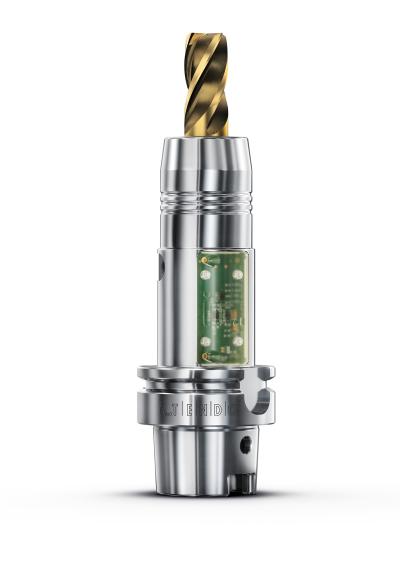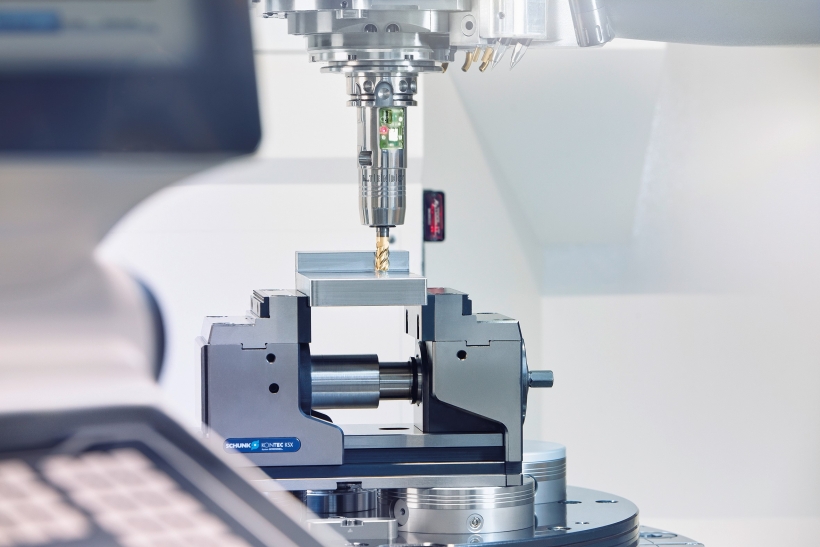
Vibrations, chatter marks, tool failure – what has so far robbed many a machine operator of sleep will soon be a thing of the past: With the smart iTENDO hydraulic expansion toolholder, SCHUNK and startup company TOOL IT present an intelligent toolholder that monitors the machining process directly at the tool, and allows real-time control of the cutting parameters.

The intelligent toolholders from SCHUNK were designed in cooperation with the Vienna University of Technology and TOOL IT GmbH, Vienna. They fully use the potential of integrated process monitoring directly where the chip is formed. SCHUNK calls this strategy "closest-to-the-part," whereby the intelligence is integrated directly into the first wear-free element of the machine equipment that is closest to the workpiece. The smart tool is offered initially in combination with SCHUNK TENDO hydraulic expansion toolholders starting in 2019, allowing complete documentation of process stability, unmanned limit value monitoring, tool breakage detection, and real-time control of the speed of rotation and feed rate.
"The iTENDO is a milestone in toolholder technology," emphasizes CEO Henrik A. Schunk. "For the first time, we combine the outstanding mechanical properties of our flagship TENDO with the possibilities of digital process monitoring.”
According to Friedrich Bleicher, the managing board director of the Institute for Manufacturing Technology (IFT) at Vienna University of Technology and founder of TOOL IT, the intelligent toolholder makes a unique synergy possible. "Embedded systems technology combines the highest degree of process transparency with the potential of autonomous process control without users having to do without the quality and performance of proven precision toolholders," explains Bleicher.
The toolholders with integrated process intelligence have the same interfering contours as conventional toolholder mountings. The use of cooling lubricant is still possible. Equipped with a sensor, battery and transmitting unit, the intelligent system records the process directly in the tool, transmits the data wirelessly to a receiving unit in the machine room, and from there via cable to a control and evaluation unit, where the data is analyzed. An algorithm continuously determines the ideal parameters for process stability. Depending on the particular application, a web service can be used to define both the exact limits and corresponding reactions if they are exceeded. The entire process’ data remains within the closed control loop of the machine, ensuring the highest possible data security.
During machining, the intelligent toolholder permanently analyzes the machining process. If the process becomes unstable, it can either be stopped in real time and without the intervention of the operator, reduced to previously defined basic parameters, or adapted until the cut returns to a stable range. The system enables complete documentation and limit value monitoring as well as an improvement of the machining quality by automatically adjusting the cutting data during vibration. Moreover, the intelligent toolholders additionally enable an analysis of the tool condition as well as increase the metal-removal rate. The system is extremely easy to retrofit without the need for modification or replacement of machine components. Since the algorithms run autonomously and the operator defines only exact limit and reactions, no expert assessment of the data is necessary. Instead, the system manages the process autonomously and in real time based on the specifications.
As a first step, SCHUNK will offer the intelligent toolholder mountings custom-tailored in the project business. At the beginning of 2019, standardization is planned within the toolholder program. In addition to TENDO hydraulic expansion toolholders, further toolholders from the SCHUNK total tooling program will be equipped with intelligent sensor systems in the future.
Contact Details
Related Glossary Terms
- chatter
chatter
Condition of vibration involving the machine, workpiece and cutting tool. Once this condition arises, it is often self-sustaining until the problem is corrected. Chatter can be identified when lines or grooves appear at regular intervals in the workpiece. These lines or grooves are caused by the teeth of the cutter as they vibrate in and out of the workpiece and their spacing depends on the frequency of vibration.
- feed
feed
Rate of change of position of the tool as a whole, relative to the workpiece while cutting.
- mechanical properties
mechanical properties
Properties of a material that reveal its elastic and inelastic behavior when force is applied, thereby indicating its suitability for mechanical applications; for example, modulus of elasticity, tensile strength, elongation, hardness and fatigue limit.
- metal-removal rate
metal-removal rate
Rate at which metal is removed from an unfinished part, measured in cubic inches or cubic centimeters per minute.
- process control
process control
Method of monitoring a process. Relates to electronic hardware and instrumentation used in automated process control. See in-process gaging, inspection; SPC, statistical process control.
- toolholder
toolholder
Secures a cutting tool during a machining operation. Basic types include block, cartridge, chuck, collet, fixed, modular, quick-change and rotating.
- web
web
On a rotating tool, the portion of the tool body that joins the lands. Web is thicker at the shank end, relative to the point end, providing maximum torsional strength.

